Søndag 14. november 2004
Første nat sov vi ikke så
godt - at sove i en fremmed seng kombineret med koranbøn fra
en nærliggende moske gav os ikke ligefrem en fredfyldt søvn.
Imidlertid var vi alle tidlig oppe for at mødes i Bedstemors
værelse for at overraske hende med danske fødselsdagssange
til flimmer med danske flag og små gaver. Denne familie overrasker
fødselaren og alle synger unisont denne meget søde fødselsdagssang.
Citadellet Muhammad Ali Moskeen
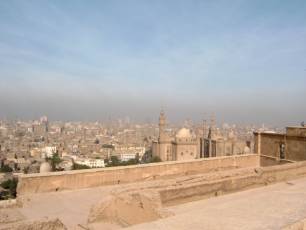 Vores
første besøg gjaldt Citadellet. Det er byens fort og husede
engang den kongelige familie og skønt det meste af komplekset
er åben for besøgende, besidder militæret stadig
en del, som er lukket område. Det tager en halv dag at komme gennem
hele Citadellet, hvilket vi ikke havde mulighed for. I stedet tilbragte
vi vores tid i Muhammed Ali moskeen. Vores
første besøg gjaldt Citadellet. Det er byens fort og husede
engang den kongelige familie og skønt det meste af komplekset
er åben for besøgende, besidder militæret stadig
en del, som er lukket område. Det tager en halv dag at komme gennem
hele Citadellet, hvilket vi ikke havde mulighed for. I stedet tilbragte
vi vores tid i Muhammed Ali moskeen.
<== Der er en fantastisk panorama over
byen fra den Vestlige terrasse - fantastisk at Cairo ikke et bygget
af ens mudderfarvede stenbygninger. Det mest bemærkelsesværdige
ved Cairo er imidlertid mangelen på farver og farverne stemmer
overens med ørkenens farver.
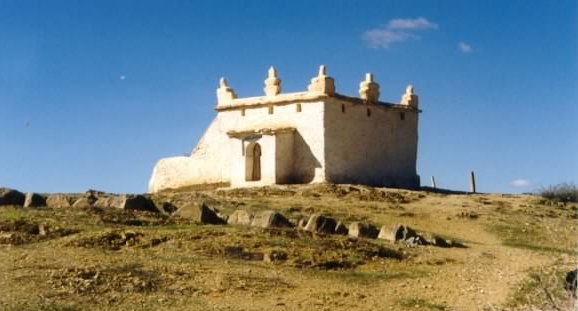 Vores
guide Adam/Mohammed gav os en ringe indsigt i funktionen eller historien
af Citadellet, og i stedet pladserede gruppen i hjørnet i hjørnet
af Muhammed Ali moskeen som en gruppe skolebørn, og gav en lektion
om Islamisk lov og sædvane. Vores
guide Adam/Mohammed gav os en ringe indsigt i funktionen eller historien
af Citadellet, og i stedet pladserede gruppen i hjørnet i hjørnet
af Muhammed Ali moskeen som en gruppe skolebørn, og gav en lektion
om Islamisk lov og sædvane.
Da René vovede sig til at spørge
om mere om Citadellet, blev han skældt ud for at afbryde og fik
besked på at lytte. Vi fik aldrig muligheden for at finde 7-tallet
Napoleons tropper hade malet over port for at undgå de uvante
arabiske navne, eller det halvrunde tårn, da vores guide simpelthen
ikke vidste, hvor de var.

I den tid havde jeg muligheden for at spadsere
lidt for mig selv og gå i moskeens skønne alabaster arkader.
Den himmelhvælvede centrale bederum var et glimmer af hundrede
af lys, der hang i koncentriske cirkler. På loftet var der arabiske
inskriptioner i guld. Kvinder skulle være anstændig klædt
og kunne ikke bære ærmeløse trøjer eller korte
shorts eller skørter. I et hjørne af rummet lå sarkofaget
med Muhhamed Ali - grundlægger af moskeen og Albanisk handelsmand,
grundlægger af dynastiet, som herskede til revolutionen i 1952.
Cairo Ægyptisk Museet
Jeg
huske turen rundt i dette museum, hvor jeg kiggede ind i smudsige glas
montre og stirrede på de rynkede ansigter af nogle engang kendte
faroer som Ramses II og undrede mig over, om disse gamle Ægyptere
var giganter i deres store kister.
20
år senere var det næsten umuligt at skubbe sig gennem mængderne
af turister - kun nyttigt fordi deres guider gav flere informationer
end vores. Med kun to timer var det umulig at se hele museet og slet
ikke de kongelige mumier.
Museet
fejrede sit hundred år med en speciel udstilling omkring TutAnkhAmun
- det mest berømte fund. Med rejseguiden i hånden "aaaede"
og "åååede" vi over guldskattene fundet
i hans grav - en guldtrone med den berømte scene med TutAnkhAmons
dronning, der tilbeder ham, kister af ibenholt og elfenben, jagtskjolde
beklædt med gepardskin, buer og pile, alabaster krukker med kong
Tuts mummificerede organer, guld sarkofager - da Howard Carter havde
fundet sådanne skatte for en lille kendt drenge-konge, forestil
jer, hvad Ramses II´s grav har indeholdt. Kong Tuts inderste kiste
af rent guld og og den berømte maske af guld, som alle gerne
vil se, er trykt i mange Ægyptiske billedmaterialer.
Museet
er blevet en ny pengemaskine for Ægypterne med yderligere en entre
for at se de kongelige mumier. Vi måtte være tilfreds med
at se dyremumierne - katte, hunde, fugle, geder, Nile Perch (ja, også
fisk!) og mest fantastisk var en 7 meter krokodillemumie.
Udstillingerne
var på øverste etage opsat efter emne og på underste
etage i kronologisk orden uret rundt fra det Gamle Kongerige, til det
midterste og sluttende med de Nye og Sidste Kongedømmer. Der
var værelser fyldt med kæmpe sarkofager (kister), som hver
ville veje en tons, et værelse fyldt med miniaturer, der viste
daglig liv i Ægypten, et værelse fuld af falmede gamle papyrusskrifter
og værelser fulde af brokker og stykker fra ruiner, statuer, palads
gulve - et sted, man kan tilbringe dage med en ordentlig rejse guide.
|
Pyramider af Giza
 Perfect Moments Photography | A Rene Pallesen Journal
Perfect Moments Photography | A Rene Pallesen Journal
eft">
14. November 2004 11:02
by Rene Pallesen
0 Comments
Bedstemor's 85th Birthday ( 13
- 20 Nov 2004 ) | |
|
Ancient Egyptian stories and legends have
long made their mark through movies such as "Cleopatra", "The
Mummy" and wowed us women with Omar Sharif's performance in "Lawrence
of Arabia" and "Doctor Zhivago" and more recently in
cartoons such as "The Prince of Egypt". There is a certain
mystic about middle east portrayed to us from a very young age when
we hear bedtime tales like "Ali Baba the 40 Thieves"
or "Sinbad the Sailor" - most of us have a dream of seeing
the pyramids.
I was very lucky to have the opportunity
20 years ago to come to Egypt with my parents and at 10 years old, there's
only so much a child can remember. But this year, the Pallesen Family
once again get together for the Matriach's 85th birthday. It is tradition
for the family to come together and travel to an exotic country - in
the past Tunisia, Morocco, Gambia and for Grandmother's last wish, to
see the pyramids of Egypt, that her husband saw 45 years earlier.
The Matriach's three children, six grandchildren
(Nikolai could not make it), four greatgrandchildren and respective
spouses all came together for a week in magical Egypt. It is autumn
with warm days and cool nights - a contrast to the approaching winter
in Denmark.
|
Saturday 13 November 2004
Departure for Egypt
Our family had to leave Falster at 2:30am
to catch a 6:30 flight, 4½hr later we arrived at Cairo Airport.
I have dim memories of a very warm airport in complete chaos, with people
pushing to get their luggage through, shouting over a mad din. Instead
we found a rather clean and uncrowded airport. We were met by the AB
Travel Agency representative, taken to a Hotel Pyramisa, left in a closed
piano bar and promptly forgotten until one of us had the bright idea to ask for
our keys.
and promptly forgotten until one of us had the bright idea to ask for
our keys.
Our family shared a two-bedroom hotel room
with a large living area. Our first afternoon was spent walking around
the streets of Cairo trying to find a place for the family to have dinner.
Our hotel was located across the river from downtown
Cairo, so there was not a lot to see, combined with the fact that
many shops were closed during the day over Ramadan, the Islamic period
of fasting from dawn to dusk. Sunday heralded the last day of Ramadan,
so many were preparing for the final feast.
In the end, the whole family had dinner
in the hotel's "Oriental" restaurant of Egyptian style. We
figured we would get some decent Egyptian food but were disappointed
to find most of our food luke-warm. The rice was very dry, little meat
on the lamb and rather bland food. To our surprise, after our comment
about this, we were presented with a complimentary platter of fruits
native to Egypt such as fresh dates and guava. To our amusement, no
matter what kind of Egyptian wine we ordered, they all tasted the same.
There was plenty of Egyptian beer and of course the danes lived up to
their drinking prowess and Bedstemor ("grandmother") treated
us all dinner.
|
Sunday 14. november 2004
On the first night we didn't sleep very
well - sleeping in a different bed combined with quranic prayers coming
from a nearby mosque didn't exactly leave us with a peaceful sleep.
However we were all up early to get together in Bedstemor's room for
a "surprise" get-together - to sing the danish birthday song
amongst a flutter of red white flags, and present her with a small
gift. This family "surprises" the birthdayee and all sing
in unison this rather cute birthday song.
The Citadel Muhammad Ali Mosque
 Our
first destination was the Citadel. It is the
city's fortress that once housed the royal family and although most
of the complex is open to visitors, the military still have a foothold
and some areas are out of bounds. It takes a half day to explore all
areas of the Citadel but we didn't have the opportunity to do so, and
instead spent most of our time in the Muhammad
Ali Mosque. Our
first destination was the Citadel. It is the
city's fortress that once housed the royal family and although most
of the complex is open to visitors, the military still have a foothold
and some areas are out of bounds. It takes a half day to explore all
areas of the Citadel but we didn't have the opportunity to do so, and
instead spent most of our time in the Muhammad
Ali Mosque.
<== There is a magnificent view of the
city from the Western Terraces - magnificent had most of Cairo not been
filled with the same shade of mud-bricked buildings. What
was most notable about Cairo was its lack of colour or rather its ability
to blend into the desert.
 Our
guide Adam/Mohammed provided little insight to the function or history
of the Citadel, and instead sat the group in one corner of the Muhammad
Ali Mosque like a bunch of school children, and gave a lecture on Islamic
laws and behaviour. Our
guide Adam/Mohammed provided little insight to the function or history
of the Citadel, and instead sat the group in one corner of the Muhammad
Ali Mosque like a bunch of school children, and gave a lecture on Islamic
laws and behaviour.
When René ventured to ask more about
the Citadel, he was scolded for interrupting and told to listen. We
never got the opportunity to find the number 7 Napoleon's troops had
painted above one doorway to avoid using the unfamiliar Arabic names
or the twin half-round towers because our guide simply didn't know where
they were.

During this time, I had the opportunity
to wander off and walk the beautiful alabaster-lined arcades of the
mosque. the soaring central prayer hall was a glimmer of hundreds of
lights hanging in concentric circles. Arabic inscriptions in gold were
painted on the ceiling. Women had to be suitably attired and could not
wear sleeveless tops or short skirts or shorts. In one corner lay the
sarcophagus of Muhammad Ali - the builder of the mosque and an albanian
mercenary who was the founder of the dynasty that ruled till the revolution
in 1952.
Cairo Egyptian Museum
I
have memories of wandering around this museum, peering into smudged
glass cases, staring into the shrivelled faces of some once well-known
pharaoh like Ramses II and wondering if the ancient Egyptians were giants
in their large coffins.
20
years later, it was almost impossible to push through the crowds of
tourists - only useful because their guides provided more information
than ours. With only two hours, there was no way that we could view
the whole museum or see the royal mummies.
The museum
was celebrating its centenary and there was a special exhibition dedicated
to TutAnkhAmun - the most famous archaeological find. With travel guide
in hand, we oohed and ahhed over the gold treasures found in his tomb
- a gold throne featuring the famous scene of TutAnkhAmun's queen anointing
him, chests made out of ebony ivory, cheetah-skinned hunting shields,
bows, arrows, alabaster canopic jars holding King Tut's mummified organs,
gold sarcophagus - if Howard Carter had found such treasures for a little
known boy-king, imagine what the tomb of a pharaoh like Ramses II would
have been like? King Tut's inner coffin of solid gold and the famous
mask of gold that everyone wants to see and is portrayed in many egyptian
images.
The museum
has become another money-making expedition for the Egyptians with an
exhorbitant price to view the royal mummies. We had to content ourselves
with the animal mummies - cats, dogs, birds, goats, Nile perch (yes,
fish as well!) and most amazing was a 7-metre crocodile mummy.
The exhibitions
were arranged by themes on the upper floor and chronological on the
lower floor, going clockwise from the Old Kingdom, to the Middle and
finally to the New and later kingdoms. There were rooms full of giant
sarcophagi that would've weighed a tonne each, a room full of miniatures
showing the egyptians' daily lives, a room full of ancient papyrus long
faded and rooms full of bits and pieces from ruins, statues, palace
floors - a place where one needs a days to spend with a decent travel
guide.
|
Khan Al-Khalili
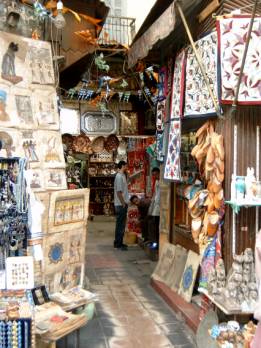 After
a stop at an egyptian perfumery and some lunch,
we headed to Khan Al-Khalili - the oldest
bazaar in Egypt that has lasted since the 1300s. Ancient buyers visited
the khan for goods brought in on merchant caravans. No longer do we
find slaves, silk, jewels or diamonds, but wooden guitars, brightly
patched pouffe covers, clothes, t-shirts, crappy papyrus paintings,
bongs/water pipes, bright bolts of cloth, the aroma of spices is very
much present and stalls are heaped with bright red, gold and blue powders
and sacks of seeds pods. Coppersmiths hammer out platters, tureens,
coffeepots and enormous crescent-shaped tops for minarets. It is a ritual
of the bazaar to expect to bargain - locals or foreign visitors - usually
a 10th of the offer price - if you have paid a third, you have paid
too much. We had only an hour to spare but many of the shops were closed
for a siesta after lunch. Ulla I pointed to bags of multicoloured
spices. He wanted £50 (AUD$10, 50DK.Kr) and after I said "da
ketir awi" (it costs too much) and walked away, the shopkeeper
doggedly followed us for a kilometre reducing the price from £40
to £30, £25, £20 and after we shouted £10 in
jest, he offered £15, £10 and finally £5 before finally
giving up on us. After much haggling, we managed to bargain for two
ornate glass perfume bottles for £20 (AUD$2.50; 20DK.Kr) After
a stop at an egyptian perfumery and some lunch,
we headed to Khan Al-Khalili - the oldest
bazaar in Egypt that has lasted since the 1300s. Ancient buyers visited
the khan for goods brought in on merchant caravans. No longer do we
find slaves, silk, jewels or diamonds, but wooden guitars, brightly
patched pouffe covers, clothes, t-shirts, crappy papyrus paintings,
bongs/water pipes, bright bolts of cloth, the aroma of spices is very
much present and stalls are heaped with bright red, gold and blue powders
and sacks of seeds pods. Coppersmiths hammer out platters, tureens,
coffeepots and enormous crescent-shaped tops for minarets. It is a ritual
of the bazaar to expect to bargain - locals or foreign visitors - usually
a 10th of the offer price - if you have paid a third, you have paid
too much. We had only an hour to spare but many of the shops were closed
for a siesta after lunch. Ulla I pointed to bags of multicoloured
spices. He wanted £50 (AUD$10, 50DK.Kr) and after I said "da
ketir awi" (it costs too much) and walked away, the shopkeeper
doggedly followed us for a kilometre reducing the price from £40
to £30, £25, £20 and after we shouted £10 in
jest, he offered £15, £10 and finally £5 before finally
giving up on us. After much haggling, we managed to bargain for two
ornate glass perfume bottles for £20 (AUD$2.50; 20DK.Kr)
|
Bedstemor's Birthday Feast
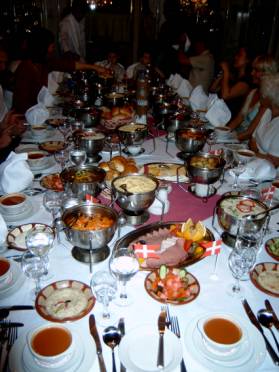 Irene
Ole had organised a private room for Bedstemor's
birthday party. A single long table in a room of egyptian style.
Small silver pots lined in two rows in the middle of the table kept
the food warm. Irene
Ole had organised a private room for Bedstemor's
birthday party. A single long table in a room of egyptian style.
Small silver pots lined in two rows in the middle of the table kept
the food warm.
We feasted on cumin-flavoured fried fish,
chicken fillets egyptian-style, cinammon-flavoured ravioli, rice, mashed
potatoes and beef steaks in pepper sauce, sang and toasted with bottles
of egyptian wine and beer to Bedstemor.
Whilst the children played in one corner,
there was much chatter througout the table and the evening finished
off with chocolate and fruit cakes topped with "Happy Pirthday"
(note, it's not an error) and we laughed in amusement in a plethora
of egyptian sweets - baklawa, semolina tarts, rose-water flavoured tarts,
and tarts that tasted like liquid honey... Ulla almost wanted to take
the rest of the desserts with her (except for the rose-water flavoured
ones - it was funny to watch her expression - rosewater almost smells
like cosmetics). The waiters were extremely attentive, coming by every
two minutes to serve us.
Best of all, Bedstemor turned 2 years old,
as she blew out each candle on the cakes. As the danes would say, "det
var meget hyggeligt!" (it was cozy)
|
Monday 15. november 2004 (7:30am start)
From the brown buildings and streets of
Cairo, we travelled 24km southeast of the city to Saqqara, changing
from a uniform brown to lush green fields of large cabbages and hundreds
of date palms. It was like an oasis, a gentle mist gave a surreal sense
of the fertile plains of ancient Egypt. Women in full-length black abeeyas
squatted in the fields, the odd man walking around - such a contrast
to the intense crowds of central Cairo.
Saqqara's Step Pyramid
Founded as a necropolis (burial city) for
the Old Kingdom and is one of the richest archaeological sites in Egypt.
The Step Pyramid
is less that ½ the height of the largest pyramids at Giza, but
this monument served as a predecessor of the smooth pyramids. Previously
tombs were made of mud brick, rectangular slablike structure covering
a burial pit. But the architect Imhotep had the bright idea to construct
in stone and  build
the slablike structure 5 times one on top of the other, creating the
first pyramid. build
the slablike structure 5 times one on top of the other, creating the
first pyramid.
We entered through the Great South Court
- the size of a soccer field, down a corridor of 40 pillars inspired
by bundles of tied reeds. Whilst Adam was making another one of his
speeches, I was tempted by a turbaned egyptian in a dress who took me
to the top where I managed to get one shot of the magnificent pillars
up top, before being scolded by Adam and being asked for baksheesh (tip).
I was gratefully rescued by a couple of Italians when the egyptian would
not let me go without a baksheesh. However, once I surfaced from the
building, I was blinded by white sands and the immense pyramid sitting
solitary amongst a few ruined stones, with a much smaller triangular
heap of stones in the background. Although the morning had been cool,
the sun soon warmed us up as we wandered round to the north.
|
Memphis
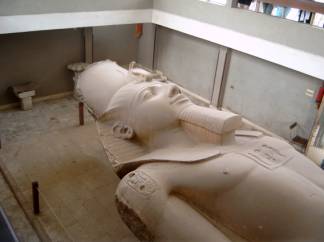 Once
the capital of ancient Egypt, it remains unexcavated
due to villages built on top of it and a high water table as a result
of the Aswan Dam. There is a small garden with small finds - bits and
pieces but the most exciting thing to see is a colossus of Ramses II
lying on his back as the lower legs are missing. The colossus would've
been 5 stories high had it been standing. Nearby lies the largest alabaster
statue ever found - 80 tons of sphinx - imagine what treasures that
could've been found if Memphis could've been excavated, especially as
this ancient city lay halfway between Upper and Lower Egypt. Once
the capital of ancient Egypt, it remains unexcavated
due to villages built on top of it and a high water table as a result
of the Aswan Dam. There is a small garden with small finds - bits and
pieces but the most exciting thing to see is a colossus of Ramses II
lying on his back as the lower legs are missing. The colossus would've
been 5 stories high had it been standing. Nearby lies the largest alabaster
statue ever found - 80 tons of sphinx - imagine what treasures that
could've been found if Memphis could've been excavated, especially as
this ancient city lay halfway between Upper and Lower Egypt.
Our final stop before lunch was a papyrus
museum - another place of commission for Adam. Bedstemor purchased a
papyrus of egyptian alphabets. Some of the paintings cost a massive
£3,500 (AUD$900, 3,500DK.Kr). For lunch, we had a splendid egyptian
meal in the middle of nowhere that served excellent mezza (egyptian
tapas) of baba ghanoush (roasted eggplant dip), tzatziki (cucumber dip),
hummus (chickpea dip), fuul (beans) served with freshly made pita bread,
warm vine-leaf rolls, lamb kofta and freshly roasted chicken in thyme.
It was feast fit for a king and the most egyptian meal we had on the
whole trip.
|
 Pyramids
of Giza Pyramids
of Giza
From air the desert pyramids were
right on the edge of the city, 16km from Cairo.
I remember vaguely, as a child, hunched
over, walking up a surprisingly warm shaft lit by a single light bulbs
and emerging into a very chilly dark room that held a single stone sarcophagus,
the room empty except for occasional square holes in the wall where
food was left for the afterlife.
I had entered the Queen's chamber in the
largest pyramid and 20 years later, only the first 300 can enter these
pyramids - for an exhorbitant fee. |
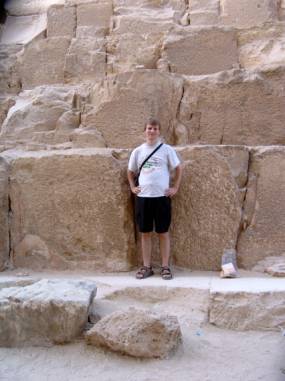
The largest of the three, Cheops' pyramid was
the largest, standing at 146metres at one point, took 920 metres to
walk around it and contained 2.3 million blocks! Each block was at least
one metre high, so you can imagine how massive these pyramids were.
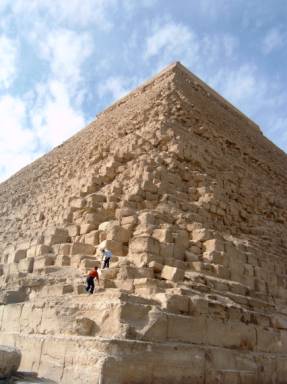
The 2nd largest, Khefren's (Cheop's son) pyramid
still had some of the smooth shiny limestone casing that once used to
cover all these pyramids.==>
The massive solar boat that once carried
the pharaoh's body from Memphis to Giza and the
three smaller Queens' pyramids stood at one corner of the massive Cheop
pyramid. We didn't have the opportunity this time to enter the tombs,
but I feel priveleged that I did and that I still have some memories
of the event.
|
The Sphinx
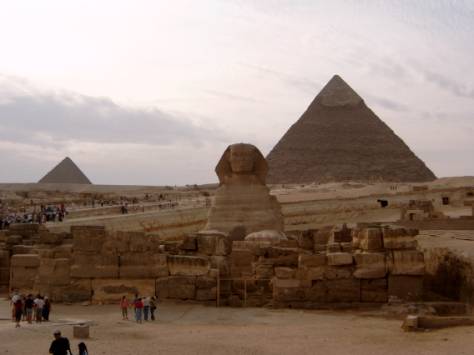 The
pyramids loomed in the background as it sat silently on the hot sand
under the glaring sunlight for 4,000 years. Napoleon's troops once used
it for target practice, so its nose and pharaohs beard and long fallen
off and lies in a British museum. The Greeks called it "the
Sphinx" as it was based on a mystical creature with the head
of a man and body of a lion, which would stop any traveller along the
way with a riddle - if the riddle wasn't answered, it became the sphinx's
dinner. Throngs of crowds surrounded the sphinx and we could only enter
in single file. Over time, it seemed that tourists could view it from
further and further away. 45 years ago, Bedstefar's (grandfather) could
touch the Sphinx and even climb to the top of the pyramid; 20 years
ago, it was simply surrounded by a small wire fence but I could stand
close up to it; now it lay in a very larg The
pyramids loomed in the background as it sat silently on the hot sand
under the glaring sunlight for 4,000 years. Napoleon's troops once used
it for target practice, so its nose and pharaohs beard and long fallen
off and lies in a British museum. The Greeks called it "the
Sphinx" as it was based on a mystical creature with the head
of a man and body of a lion, which would stop any traveller along the
way with a riddle - if the riddle wasn't answered, it became the sphinx's
dinner. Throngs of crowds surrounded the sphinx and we could only enter
in single file. Over time, it seemed that tourists could view it from
further and further away. 45 years ago, Bedstefar's (grandfather) could
touch the Sphinx and even climb to the top of the pyramid; 20 years
ago, it was simply surrounded by a small wire fence but I could stand
close up to it; now it lay in a very larg |
|